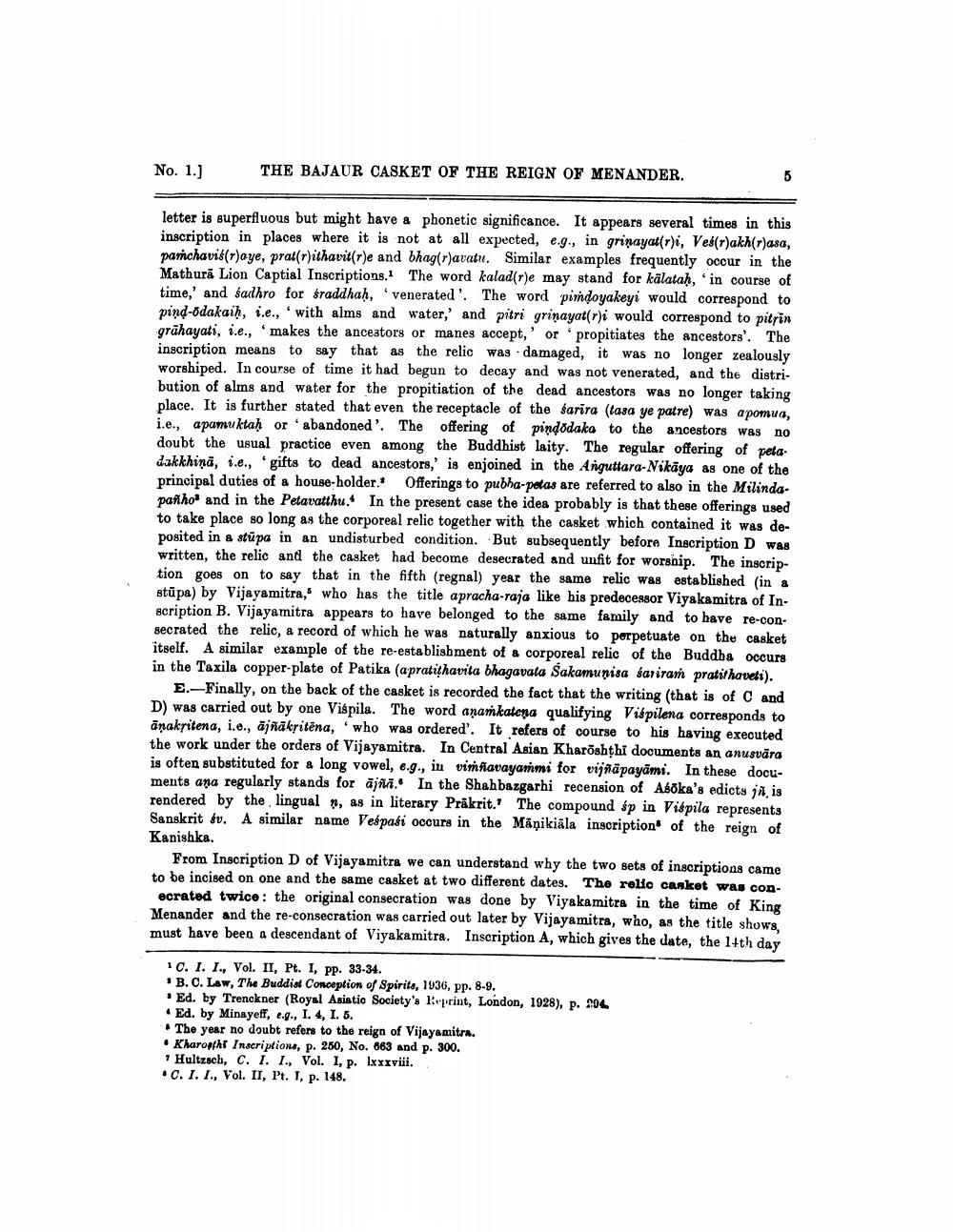________________
No. 1.]
THE BAJAUR CASKET OF THE REIGN OF MENANDER.
letter is superfluous but might have a phonetic significance. It appears several times in this inscription in places where it is not at all expected, e.g., in grinayat(r)i, Ves(r)akh(r)asa, pamchavis(r)aye, prat(r)ithavit(r)e and bhag(r)avatu. Similar examples frequently occur in the Mathura Lion Captial Inscriptions. The word kalad(r)e may stand for kalataḥ, in course of time,' and sadhro for sraddhaḥ, venerated'. The word pimdoyakeyi would correspond to pind-odakaiḥ, i.e., with alms and water,' and pitri grinayat(r)i would correspond to pitrin grahayati, i.e., makes the ancestors or manes accept,' or 'propitiates the ancestors'. The inscription means to say that as the relic was damaged, it was no longer zealously worshiped. In course of time it had begun to decay and was not venerated, and the distribution of alms and water for the propitiation of the dead ancestors was no longer taking place. It is further stated that even the receptacle of the sarira (tasa ye patre) was apomua, i.e., apamuktaḥ or abandoned'. The offering of pindodaka to the ancestors was no doubt the usual practice even among the Buddhist laity. The regular offering of petadakkhina, i.e., gifts to dead ancestors,' is enjoined in the Anguttara-Nikaya as one of the principal duties of a house-holder. Offerings to pubha-petas are referred to also in the Milindapañho and in the Petavatthu. In the present case the idea probably is that these offerings used to take place so long as the corporeal relic together with the casket which contained it was deposited in a stupa in an undisturbed condition. But subsequently before Inscription D was written, the relic and the casket had become desecrated and unfit for worship. The inscription goes on to say that in the fifth (regnal) year the same relic was established (in a stupa) by Vijayamitra, who has the title apracha-raja like his predecessor Viyakamitra of Inscription B. Vijayamitra appears to have belonged to the same family and to have re-consecrated the relic, a record of which he was naturally anxious to perpetuate on the casket itself. A similar example of the re-establishment of a corporeal relic of the Buddha occurs in the Taxila copper-plate of Patika (apratiṭhavita bhagavata Sakamunisa sariram pratithaveti).
5
E. Finally, on the back of the casket is recorded the fact that the writing (that is of C and D) was carried out by one Vispila. The word anamkatena qualifying Vispilena corresponds to anakritena, i.e., ajñākritēna, who was ordered'. It refers of course to his having executed the work under the orders of Vijayamitra. In Central Asian Kharoshṭhi documents an anusvāra is often substituted for a long vowel, e.g., in vimñavayammi for vijñāpayāmi. In these documents ana regularly stands for ajña. In the Shahbazgarhi recension of Asoka's edicts jn, is rendered by the lingual, as in literary Prakrit. The compound sp in Vispila represents Sanskrit év. A similar name Vespasi occurs in the Manikiāla inscription of the reign of Kanishka.
From Inscription D of Vijayamitra we can understand why the two sets of inscriptions came to be incised on one and the same casket at two different dates. The relic casket was conecrated twice: the original consecration was done by Viyakamitra in the time of King Menander and the re-consecration was carried out later by Vijayamitra, who, as the title shows, must have been a descendant of Viyakamitra. Inscription A, which gives the date, the 14th day
1 C. I. I., Vol. II, Pt. I, pp. 33-34.
B. C. Law, The Buddist Conception of Spirits, 1936, pp. 8-9.
Ed. by Trenckner (Royal Asiatic Society's Reprint, London, 1928), p. 294.
Ed. by Minayeff, e.g., I. 4, I. 5.
The year no doubt refers to the reign of Vijayamitra.
Kharosthi Inscriptions, p. 250, No. 663 and p. 300.
7 Hultzsch, C. I. I., Vol. I, p. lxxxviii. C. I. I., Vol. II, Pt. I, p. 148.




